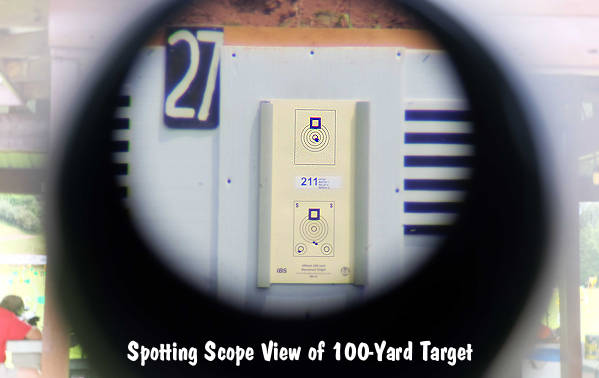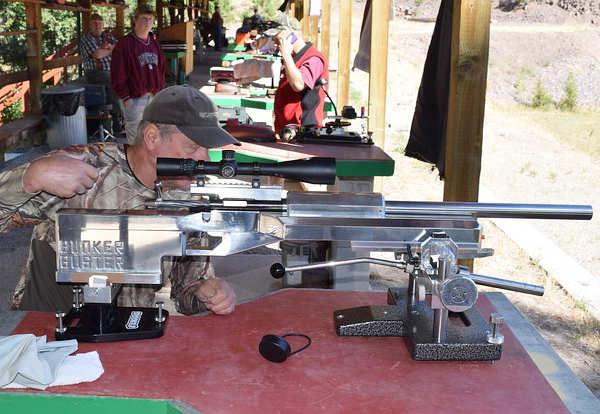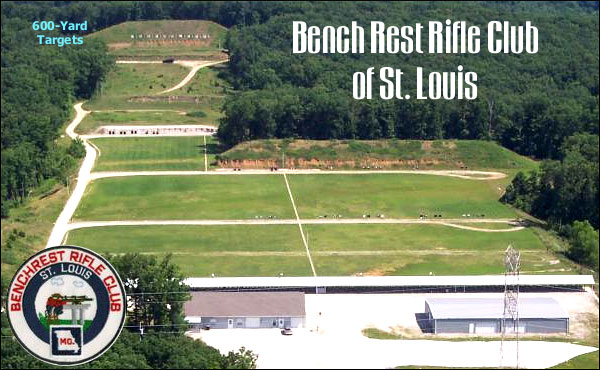![IBS Group Benchrest Nationals Union County Weikert PA Pennsylvania 6PPC 30 Dasher Tony Boyer]()
IBS Group Nationals — July 13-18, 2015
Report by IBS President Jeff Stover
The ancient benchrest alchemists once predicted a perfect storm for small groups. The recipe is: one part near ideal shooting conditions, 90 of the best benchrest shooters in North America and mix with the shooters’ best barrels and bullets. Place the entire concoction at the shooting benches for seven minutes at time. The result in Heavy Varmint (13.5-lb rifles) at 100 yards, for example, was that the top 17 shooters averaged under .200 for their five targets! Yes, nearly the entire Top 20 in HV100 shot a “teen agg”. Ten or fifteen years ago, that would have been unthinkable. Sure, the winners or top two or three would be in that rarefied air, but not half of an entire relay of 40 shooters. Remarkable.
Bill Sutton of Hart Rifle Barrels
![IBS Group Benchrest Nationals Union County Weikert PA Pennsylvania 6PPC 30 Dasher Tony Boyer]()
IBS Group Nationals Full Results (XLS Spreadsheet) | IBS Group Nationals Equipment List
![IBS Group Benchrest Nationals Union County Weikert PA Pennsylvania 6PPC 30 Dasher Tony Boyer]() Another landmark of the 2015 IBS Nationals was that 17-year-old Wyatt Peinhardt of Quarryville, PA won the 200-yard stage of Heavy Bench. That meant he earned his first point toward the U. S. Benchrest Hall of Fame (HOF). You need ten to get in, but young Wyatt has plenty of time to get the other nine. He is no ‘flash in pan’. The young Mr. Peinhardt has been shooting since 2009 and now runs full speed with the big dogs of the sport. He was in the Top 20 in this year’s Super Shoot 2-gun results. Frequently he battles his dad, Jeff for supremacy at the bench. Strangely enough, here at Weikert in the Sporter Grand Aggregate (average of five targets at both 100 and 200 yards) Wyatt and his father tied right down to four decimal places: 0.2317!
Another landmark of the 2015 IBS Nationals was that 17-year-old Wyatt Peinhardt of Quarryville, PA won the 200-yard stage of Heavy Bench. That meant he earned his first point toward the U. S. Benchrest Hall of Fame (HOF). You need ten to get in, but young Wyatt has plenty of time to get the other nine. He is no ‘flash in pan’. The young Mr. Peinhardt has been shooting since 2009 and now runs full speed with the big dogs of the sport. He was in the Top 20 in this year’s Super Shoot 2-gun results. Frequently he battles his dad, Jeff for supremacy at the bench. Strangely enough, here at Weikert in the Sporter Grand Aggregate (average of five targets at both 100 and 200 yards) Wyatt and his father tied right down to four decimal places: 0.2317!
Six Days of Competition with Four Classes
Some say that the Group Nationals are a marathon — six long days of competition at both 100 and 200 yards with four classes of rifles: Light Varmint (10.5 lb); Sporter (10.5 lb – 6mm minimum caliber); Heavy Varmint (13.5 lb) and Heavy Bench (known as ‘Unlimited’ in NBRSA-land). The first three are simply known as the “bag guns”. Most competitors use a 10.5-lb rifle in 6PPC and compete in all three classes. The Heavy Bench (HB) class requires 10-shot groups as opposed to the 5-shot ones for the bag guns. There is no prohibition to shooting your 10.5-pound rifle in HB, but a shooter is simply outclassed by the rail guns, especially for 10-shot groups.
![IBS Group Benchrest Nationals Union County Weikert PA Pennsylvania 6PPC 30 Dasher Tony Boyer]()
As mentioned, the week’s weather was very good. After what seemed like weeks of on and off rain, the central Pennsylvania weather gods smiled on what is considered one of the most beautiful ranges in the USA. The shooters had nice sunshine and instead of the usual Weikert blow, they were treated to light zephyrs. It was a glorious week to be at a rifle match.
![IBS Group Benchrest Nationals Union County Weikert PA Pennsylvania 6PPC 30 Dasher Tony Boyer]()
Course of Fire — First 100, then 200
The sequence of competition groups has 100-yard targets shot the first three days followed by three days at 200 yards. It is done this way to require only one change of wind flags. Nationals competition requires ‘full rotation’. That means that every time a shooter goes to the line for the next match target, he or she must move a requisite number of benches to the right. At the end of the day a shooter will shoot across the full width of the line. Some ranges offer unique properties that render some parts of the range harder or easier to shoot small groups. Bench rotation is important to even out those factors.
![IBS Group Benchrest Nationals Union County Weikert PA Pennsylvania 6PPC 30 Dasher Tony Boyer]()
Monday morning saw the Heavy Bench (HB) shooters hauling the big rail guns to the line. Old pro Jack Neary led the way at 100 yards with .2186 Aggregate. The 200-yard stage for HB would not be held until Saturday morning. The winner there, of course, was Wyatt Peinhardt with his .2993 (MOA conversion for 200-yard scores). On Tuesday the bags guns came out for Light Varmint (LV) and Sporter (SP). Conditions allowed for quite a few very good groups. The top thirteen shooters in Sporter shot ‘teen aggs’ with Bart Sauter leading the way at a .1666. In Light Varmint, Wayne Campbell shot a tiny .1556. Both his warm-up and first record target were in the ‘zeroes’ (.096 and .088)!
Wednesday’s 100-yard Heavy Varmint match enjoyed what were probably the best conditions of the week. You needed to average under .200 for five targets to finish in the Top 20 or nearly so. Harley Baker won with a .1616. The talk in the loading area was Baker’s fourth record target — a tiny 0.050 bughole centered right in the center ring (usually called the ‘mothball’). It was probably the prettiest target most had ever seen. Better yet, the standing IBS HV 100 record is a 0.052 shot way back in 1980. Harley’s target is being submitted to the IBS Measuring Committee as a potential IBS record.
![IBS Group Benchrest Nationals Union County Weikert PA Pennsylvania 6PPC 30 Dasher Tony Boyer]()
Wednesday afternoon saw the moving of flags for the 200-yard stage of the competition. The SP and LV 200-yard targets were Thursday’s course of fire. In LV, Andy Shifflett shot a .1966 Aggregate to pick up a HOF point. At 200 yards, Aggregates are logged in MOA units. Therefore, Andy’s .1966 Aggregate translates to an average 200-yard target measurement of slightly less than .400″. The afternoon was reserved for SP targets. Billy Stevens shot a .2060 to win the afternoon’s contest.
Powderpuff Event at the IBS Group Nationals
For decades IBS has hosted an exhibition shoot on the afternoon of a day when only one Aggregate is contested instead of two. It is called the Powderpuff and is intended to allow family members and others that do not shoot competitively to give benchrest shooting a try. Each shooter is assisted by a coach who instructs the shooter. World-class shooters such as Gene Bukys and Lester Bruno give their time and talents to assist novice shooters. There is no time limit to rattle the inexperienced shooters.
2015 Powderpuff Winners Jaydin Johnson (left) and Pam Campbell (right)
![IBS Group Benchrest Nationals Union County Weikert PA Pennsylvania 6PPC 30 Dasher Tony Boyer]()
![IBS benchrest Powderpuff Youth match Weikert PA Group Nationals]()
Barbara Hottenstein continued as the Powderpuff chair and assembled a large array of awards and prizes. The competition is financially supported by the IBS President’s Fund. This year we had 12 youth and adult competitors. Pam Campbell won the adult category while Jaydin Johnson (shown above with coach Nancy Scarbrough) won the youth division.
On Friday, a single Aggregate of five record targets were shot-for Heavy Varmint (HV) at 200 yards. Harley Baker had his mojo working with a .1896 Aggregate. That performance, coupled with Harley’s .1616 at 100 yards meant that his average in the HV class was a .1756 Grand Aggregate. That is small. Really small.
On Friday afternoon, many of the awards for bag guns were given out. Saturday was reserved for HB 200. Since some of the bag gun shooters do not shoot a rail gun, a number of competitors left Friday afternoon. The rail guns came out to contest 200 yards on the last day of the Nationals. The winner was Wyatt Peindardt. His .2993 was the only Aggregate under .300. Wayne Campbell was second with a .3028. Winning the HB Grand Aggregate was two-time Super Shoot winner, Larry Costa.
![IBS Group Benchrest Nationals Union County Weikert PA Pennsylvania 6PPC 30 Dasher Tony Boyer]()
IBS recognizes Aggregate performances as follows: Grand (100 + 200) Aggregates in each of four classes; Two-Gun (all HV and LV targets in 100 + 200); Three-gun (HV, LV, SP in 100 + 200) and 4-gun (HV, LV, SP and HB in 100 + 200). In the multi-guns, Harley Baker won the Two-Gun. Gene Bukys added more HOF points by winning the Three-Gun. In the Four-Gun, Virginia’s Wayne Campbell who took the overall four-class Agg with an excellent .2326.
Praise for the Range Crew and Sponsors
The IBS Group Nationals requires a ton of work to run smoothly. The Weikert range’s sparkplugs are Mark Trutt and Dale Boop. This shoot does not happen without those two. This year’s registration and general admin fell to Nancy Scarbrough, who ran a flawless operation. She was assisted by Will Baylor in the scoring and by Stacy Hynes. Steve Dodge oversaw the entire target crew while Larry Hertzog alternated with Mark Trutt as Range Officer.
The benchrest cottage industry should be commended for giving back to the shooters. This year’s sponsors included: BAT actions, Black Hills Shooters Supply, Boops Sporting Goods, Bruno Shooters Supply, Hart Rifle Barrels, Jewel Triggers, JDS Bullets, K&M Precision Shooting, Krieger Rifle Barrels, L. E. Wilson, Pacific Tool & Gauge, and Shilen Rifle Barrels.
Parting Shot — Some Competitors tried to keep up with work while reloading …
![IBS Group Benchrest Nationals Union County Weikert PA Pennsylvania 6PPC 30 Dasher Tony Boyer]()
Share the post "Match Report: 2015 IBS Group Nationals in Pennsylvania"
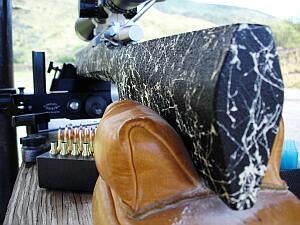 Back in the old days, about the time Fred Flintstone was still alive, I worked for Pat McMillan for free, from time to time to learn all his secrets. One day little Speedy was filling some new sand bags out behind Pat’s shop, stuffing them with more sand than Taco Bell put beans in their Burritos. When Pat stepped out the back door and inquired as to what in the hell was I doing packing them there bags the way I was.
Back in the old days, about the time Fred Flintstone was still alive, I worked for Pat McMillan for free, from time to time to learn all his secrets. One day little Speedy was filling some new sand bags out behind Pat’s shop, stuffing them with more sand than Taco Bell put beans in their Burritos. When Pat stepped out the back door and inquired as to what in the hell was I doing packing them there bags the way I was. 




 Building your own portable shooting bench is a great do-it-yourself project. You can build a sturdy bench for well under $100 in materials. Compare that to some deluxe factory-built benches which may cost $500.00 or more.
Building your own portable shooting bench is a great do-it-yourself project. You can build a sturdy bench for well under $100 in materials. Compare that to some deluxe factory-built benches which may cost $500.00 or more.
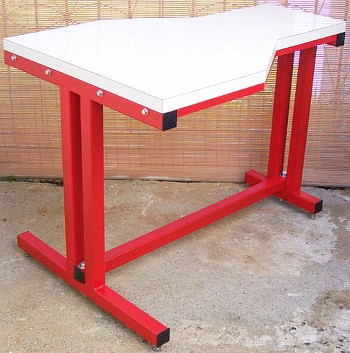








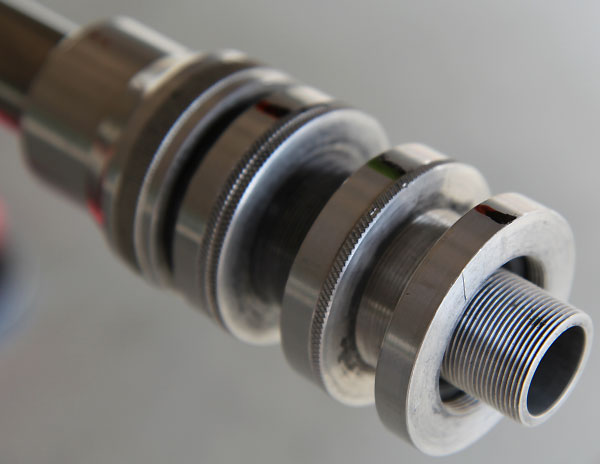










 We know that many of our readers have never seen a “Hammerhead” benchrest stock before. This is a design with an extra wide section in the very front, tapering to a narrow width starting about 6″ back. When paired with a super-wide front sandbag, the hammerhead design provides added stability — just like having a wider track on a racing car. Some folks think mid-range and long-range benchrest stocks can only be 3″ wide. Not so — IBS and NBRSA rules now allow much wider fore-ends. While F-Class Open rules limit fore-end width to 3″ max, there is not such restriction on IBS or NBRSA Light Guns or Heavy Guns for 600- and 1000-yard competition. Here’s a 5″-wide Hammerhead design from
We know that many of our readers have never seen a “Hammerhead” benchrest stock before. This is a design with an extra wide section in the very front, tapering to a narrow width starting about 6″ back. When paired with a super-wide front sandbag, the hammerhead design provides added stability — just like having a wider track on a racing car. Some folks think mid-range and long-range benchrest stocks can only be 3″ wide. Not so — IBS and NBRSA rules now allow much wider fore-ends. While F-Class Open rules limit fore-end width to 3″ max, there is not such restriction on IBS or NBRSA Light Guns or Heavy Guns for 600- and 1000-yard competition. Here’s a 5″-wide Hammerhead design from 






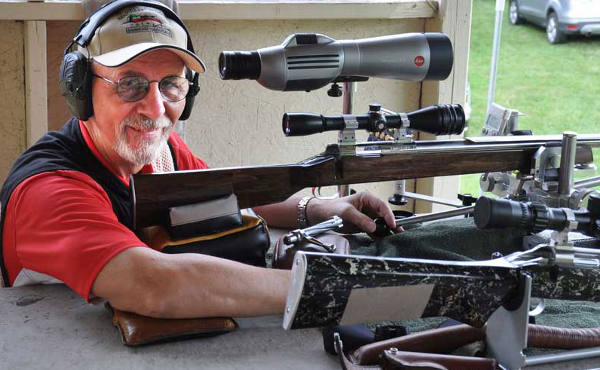


 Saturday the targets were moved back to 200 yards and the fun continued. Hall-of-Famer Allie Euber from Vermont took top honors in VFS class with a 250-14X score from his LV rifle. In the Points Race for Score Shooter Of the Year (SSOY), it was another sweep for the Southern contingent. Under IBS rules, only the first rifle one shoots may garner SSOY points. Allie did, in fact, win the 200 VFS stage (with his LV). However, as he shot his HV rifle on the second relay and his LV on the third relay, Allie picked up no SSOY points.
Saturday the targets were moved back to 200 yards and the fun continued. Hall-of-Famer Allie Euber from Vermont took top honors in VFS class with a 250-14X score from his LV rifle. In the Points Race for Score Shooter Of the Year (SSOY), it was another sweep for the Southern contingent. Under IBS rules, only the first rifle one shoots may garner SSOY points. Allie did, in fact, win the 200 VFS stage (with his LV). However, as he shot his HV rifle on the second relay and his LV on the third relay, Allie picked up no SSOY points.





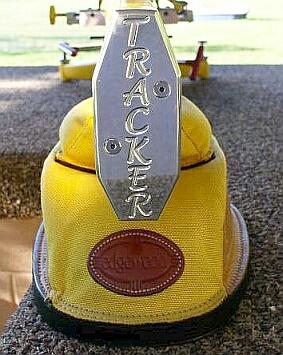 1. Align Front Rest and Rear Bags. We see many shooters whose rear bag is angled left or right relative to the bore axis. This can happen when you rush your set-up. But even if you set the gun up carefully, the rear bag can twist due to recoil or the way your arm contacts the bag. After every shot, make sure your rear bag is aligned properly (this is especially important for bag squeezers who may actually pull the bag out of alignment as they squeeze).
1. Align Front Rest and Rear Bags. We see many shooters whose rear bag is angled left or right relative to the bore axis. This can happen when you rush your set-up. But even if you set the gun up carefully, the rear bag can twist due to recoil or the way your arm contacts the bag. After every shot, make sure your rear bag is aligned properly (this is especially important for bag squeezers who may actually pull the bag out of alignment as they squeeze). 3. Weigh Your Charges — Every One. This may sound obvious, but many folks still rely on a powder measure. Yes we know that most short-range BR shooters throw their charges without weighing, but if you’re going to pre-load for a club match there is no reason NOT to weigh your charges. You may be surprised at how inconsistent your powder measure actually is. One of our testers was recently throwing H4198 charges from a Harrell’s measure for his 30BR. Each charge was then weighed twice with a Denver Instrument lab scale. Our tester found that thrown charges varied by up to 0.7 grains! And that’s with a premium measure.
3. Weigh Your Charges — Every One. This may sound obvious, but many folks still rely on a powder measure. Yes we know that most short-range BR shooters throw their charges without weighing, but if you’re going to pre-load for a club match there is no reason NOT to weigh your charges. You may be surprised at how inconsistent your powder measure actually is. One of our testers was recently throwing H4198 charges from a Harrell’s measure for his 30BR. Each charge was then weighed twice with a Denver Instrument lab scale. Our tester found that thrown charges varied by up to 0.7 grains! And that’s with a premium measure. 5. Check Your Fasteners. Before a match you need to double-check your scope rings or iron sight mounts to ensure everything is tight. Likewise, you should check the tension on the screws/bolts that hold the action in place. Even with a low-recoiling rimfire rifle, action screws or scope rings can come loose during normal shooting.
5. Check Your Fasteners. Before a match you need to double-check your scope rings or iron sight mounts to ensure everything is tight. Likewise, you should check the tension on the screws/bolts that hold the action in place. Even with a low-recoiling rimfire rifle, action screws or scope rings can come loose during normal shooting.

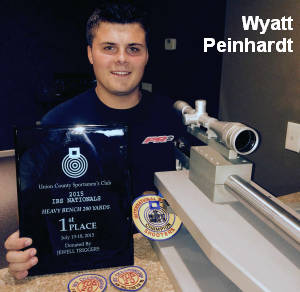 Another landmark of the 2015 IBS Nationals was that 17-year-old Wyatt Peinhardt of Quarryville, PA won the 200-yard stage of Heavy Bench. That meant he earned his first point toward the U. S. Benchrest Hall of Fame (HOF). You need ten to get in, but young Wyatt has plenty of time to get the other nine. He is no ‘flash in pan’. The young Mr. Peinhardt has been shooting since 2009 and now runs full speed with the big dogs of the sport. He was in the Top 20 in this year’s Super Shoot 2-gun results. Frequently he battles his dad, Jeff for supremacy at the bench. Strangely enough, here at Weikert in the Sporter Grand Aggregate (average of five targets at both 100 and 200 yards) Wyatt and his father tied right down to four decimal places: 0.2317!
Another landmark of the 2015 IBS Nationals was that 17-year-old Wyatt Peinhardt of Quarryville, PA won the 200-yard stage of Heavy Bench. That meant he earned his first point toward the U. S. Benchrest Hall of Fame (HOF). You need ten to get in, but young Wyatt has plenty of time to get the other nine. He is no ‘flash in pan’. The young Mr. Peinhardt has been shooting since 2009 and now runs full speed with the big dogs of the sport. He was in the Top 20 in this year’s Super Shoot 2-gun results. Frequently he battles his dad, Jeff for supremacy at the bench. Strangely enough, here at Weikert in the Sporter Grand Aggregate (average of five targets at both 100 and 200 yards) Wyatt and his father tied right down to four decimal places: 0.2317!

